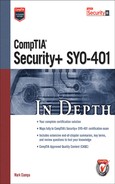Book Description
COMPTIA SECURITY+ SY0-401 IN DEPTH will prepare you to pass CompTIA's new Security+ certification exam and earn this important credential in the field of computer security. This book offers in-depth coverage of all relevant topics, from handling malware to advanced cryptography, wireless and mobile security, and much more. Using the proven In Depth certification training method, this comprehensive, up-to-date, user-friendly test-prep guide covers exam objectives for the new Security+ SY0-401 certification exam; features end-of-chapter quizzes to test your mastery of each new skill you're learning; maps completely to the Security+ SY0-401 exam objectives; and includes a full glossary and helpful appendixes. Computer and network security is a crucially important and ever-growing field, and IT professionals must keep up with the latest challenges and technologies. The CompTIA Security+ SY0-401 certification exam validates the knowledge and best practices required of professionals responsible for securing computer networks and managing risk. The coaching and test-prep resources contained in COMPTIA SECURITY+ SY0-401 IN DEPTH will give you the skills and confidence you'll need to succeed on exam day.
Book Description
COMPTIA SECURITY+ SY0-401 IN DEPTH will prepare you to pass CompTIA's new Security+ certification exam and earn this important credential in the field of computer security. This book offers in-depth coverage of all relevant topics, from handling malware to advanced cryptography, wireless and mobile security, and much more. Using the proven In Depth certification training method, this comprehensive, up-to-date, user-friendly test-prep guide covers exam objectives for the new Security+ SY0-401 certification exam; features end-of-chapter quizzes to test your mastery of each new skill you're learning; maps completely to the Security+ SY0-401 exam objectives; and includes a full glossary and helpful appendixes. Computer and network security is a crucially important and ever-growing field, and IT professionals must keep up with the latest challenges and technologies. The CompTIA Security+ SY0-401 certification exam validates the knowledge and best practices required of professionals responsible for securing computer networks and managing risk. The coaching and test-prep resources contained in COMPTIA SECURITY+ SY0-401 IN DEPTH will give you the skills and confidence you'll need to succeed on exam day.
Table of Contents
- Title Page
- Copyright Page
- Brief Contents
- Table of Contents
- INTRODUCTION
- CHAPTER 1 Introduction to Security
- PART I Threats
- PART II Application, Data, and Host Security
- PART III Cryptography
- PART IV Network Security
- CHAPTER 7 Network Security Fundamentals
- CHAPTER 8 Administering a Secure Network
- PART V Mobile Security
- CHAPTER 9 Wireless Network Security
- CHAPTER 10 Mobile Device Security
- PART VI Access Control and Identity Management
- CHAPTER 11 Access Control Fundamentals
- CHAPTER 12 Authentication and Account Management
- PART VII Compliance and Operational Security
- CHAPTER 13 Business Continuity
- CHAPTER 14 Risk Mitigation
- CHAPTER 15 Vulnerability Assessment
- APPENDIX A CompTIA SY0-401 Certification Exam Objectives
- APPENDIX B Answers to Chapter Review Questions
- APPENDIX C Security Websites
- APPENDIX D Selected TCP/IP Ports and Their Threats
- APPENDIX E References
- GLOSSARY
- INDEX
